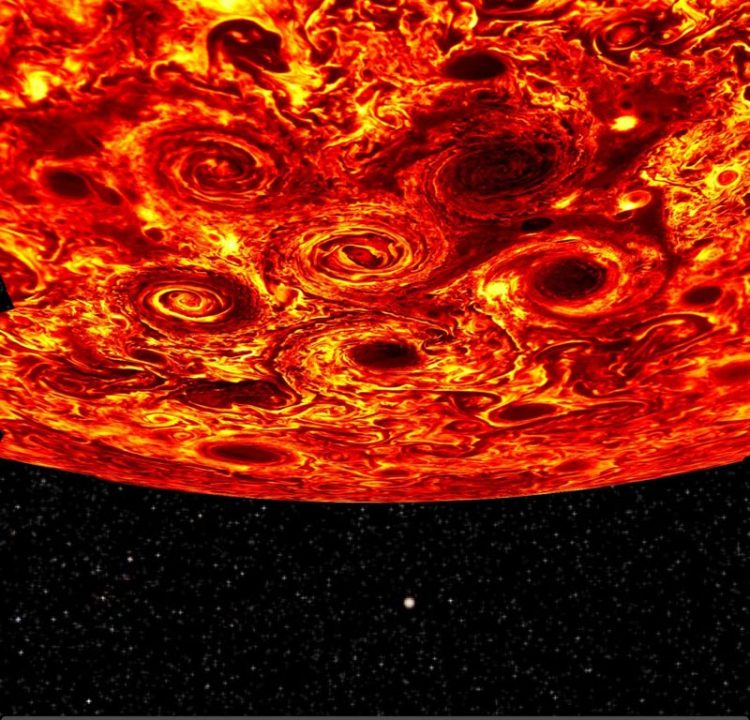First look at Jupiter's poles show strange geometric arrays of storms

Five massive storms form a pentagon around a storm at the center of Jupiter's south pole-the first look we've ever gotten at the gas giant's poles, and a scientific mystery. Credit: NASA/SWRI/JPL/ASI/INAF/IAPS
But in the past two years, with NASA's Juno spacecraft, scientists have gotten a good look at the top and bottom of the planet for the first time. What they found astounded them: bizarre geometric arrangements of storms, each arrayed around one cyclone over the north and south poles–unlike any storm formation seen in the universe.
The study, authored by scientists from an international group of institutions including the University of Chicago, is published in March 8's Nature as part of a set of four papers dedicated to new observations from the Juno spacecraft.
Juno launched in 2011 with the ambitious mission of finally seeing beneath the dense clouds covering Jupiter. On July 4, 2016, it finally reached the planet's orbit. Since then it's been orbiting the planet, taking pictures and measuring the planet's profile in infrared, microwave, ultraviolet, gravity and magnetism–and answering questions scientists have had about Jupiter for decades.
One of these was the question of what lay at its elusive poles. When scientists got the first images, they were stunned. At the north pole, eight storms surrounded one storm at the center. At the south pole, it was the same arrangement, only with five storms. But the numbers stayed oddly constant; the storms weren't drifting and merging, as our current understanding of the science suggested they should.
“They are extraordinarily stable arrangements of such chaotic elements,” said Morgan O'Neill, a University of Chicago postdoctoral scholar and a co-author on the paper. “We'd never seen anything like it.”
The geometry rang a faint bell in O'Neill's mind, though. She found it in the library of strange physical phenomena only observed under special conditions in the laboratory. In the 1990s, scientists observed a similar behavior as they used electrons to simulate a frictionless, turbulent 2-D fluid as it cools. Instead of merging, which tends to happen in such 2-D flows, small vortices would clump together and form equally spaced arrays, or “vortex crystals,” around a center.
It's not yet clear whether the same physics underlies both these behaviors, O'Neill said, but it is tantalizing. “The next step is: Can you create a model that builds a virtual planet and predicts these flows?” she said. With further studies, they can understand the forces at play in the swirling storms.
A greater understanding of the physics behind the flows and dynamics of storms is helpful on every planet; though O'Neill did her PhD on the dynamics of cyclones on gas giants (including a prediction that Jupiter's poles would not look like Saturn's: “I got it…partially right,” she said), she now uses similar storm modeling to study hurricanes on Earth.
###
The study was led by Alberto Adriani with Rome's Institute for Space Astrophysics and Planetology. Other authors on the study were from the Jet Propulsion Laboratory, Caltech, the British Astronomical Association, the Southwest Research Institute, NASA Goddard Space Flight Center, the University of Michigan, Cornell University, the University of Atacama in Chile and the Planetary Science Institute, as well as the Institute for Space Astrophysics and Planetology, the University of Bologna, the Italian Space Agency and the Institute of Atmospheric Sciences and Climate, all in Italy.
Media Contact
All latest news from the category: Physics and Astronomy
This area deals with the fundamental laws and building blocks of nature and how they interact, the properties and the behavior of matter, and research into space and time and their structures.
innovations-report provides in-depth reports and articles on subjects such as astrophysics, laser technologies, nuclear, quantum, particle and solid-state physics, nanotechnologies, planetary research and findings (Mars, Venus) and developments related to the Hubble Telescope.
Newest articles

Sea slugs inspire highly stretchable biomedical sensor
USC Viterbi School of Engineering researcher Hangbo Zhao presents findings on highly stretchable and customizable microneedles for application in fields including neuroscience, tissue engineering, and wearable bioelectronics. The revolution in…

Twisting and binding matter waves with photons in a cavity
Precisely measuring the energy states of individual atoms has been a historical challenge for physicists due to atomic recoil. When an atom interacts with a photon, the atom “recoils” in…

Nanotubes, nanoparticles, and antibodies detect tiny amounts of fentanyl
New sensor is six orders of magnitude more sensitive than the next best thing. A research team at Pitt led by Alexander Star, a chemistry professor in the Kenneth P. Dietrich…





















